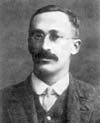
William Sealey Gosset
Gosset was a chemist and statistician employed by the Guinness Brewery in Dublin. He devised important statistical methods for analyzing the small sample sizes available for monitoring quality control at the brewery. While he had degrees from Oxford in both Chemistry ahd Mathematics, in 1906-07 he travelled to University College in London to study further under Pearson. He continued his correspondences with Pearson and with Neyman and Fisher.
Gosset published pioneering research on the analysis of small samples, using a combination of empirical and theoretical tools. His techniques were an early application of the Monte Carlo method.
Gosset published his statsitical work under the pseudonym "A. Student." Most statistics books today will contain "Student's t-tables" for working with small samples, so that today he is much better known by his pseudonym than by his real name. Tradition has it that he published under a pseudonym because his employer, while encouraging and funding his research, discouraged scholarly publication; however there is no documentary evidence of this.
Gosset was described in contemporary accounts as "kindly and beloved" by his employers and friends. It is noteworthy that he appears to have gotten along with Fisher and both Pearsons despite the vitriolic feuds within the statistical community of the day.
Born: 13 June 1876 in Canterbury, England
Died: 16 Oct 1937 in Beaconsfield, England
The premiere site for biographies of mathematicians on the web is at The University of Saint Andrews in Scotland; this is the primary source of the information in these short biographies. Some biographies used additional web resources as noted in the biography.
The postage stamp images came from a wonderful site on mathematicians on stamps maintained by Jeff Miller, a mathematics teacher in Florida.
The Free Internet Encyclopedia Wikipedia is also an excellent source of information and was used as a reference for many bographies.
The opinions expressed in these biographies are those of the author and do not reflect official views of the University of Oklahoma.
